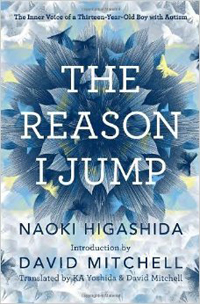Book Notes
 Naoki Higashida, The Reason I Jump; The Inner Voice of a Thirteen-Year-Old Boy With Autism, translated by K.A. Yoshida and David Mitchell (New York: Random House, 2013), 135pp.
Naoki Higashida, The Reason I Jump; The Inner Voice of a Thirteen-Year-Old Boy With Autism, translated by K.A. Yoshida and David Mitchell (New York: Random House, 2013), 135pp.
Naoki Higashida (b. 1992) was five years old when he was diagnosed with a form of autism that included severe speech impairment. Eventually, he learned to spell words by pointing to the letters and symbols on an alphabet grid. When he was thirteen, he published this book in Japan (2007). Yoshida and Mitchell, who are married and also have an autistic son, have translated the book into English. They begin the book with a short introduction.
You can read this book in two hours. It follows an interview format of 58 questions that are posed to Higashida. The questions cover what you would expect in a candid discussion about autism — huge outbursts over minor issues, impulsive speech, repeating questions, tactile sensitivity, the lack of eye contact, waving good-bye with his palm turned inward, and so on. Each response is about a page long. The title of the book comes from question #25: "What's the reason you jump?"
With their own autistic son, the translators are not impartial observers. They draw a radical and controversial conclusion from Higashida's answers that reverses the standard understanding of autism. People with autism are not antisocial loners who lack empathy, they claim. Rather, "both emotional poverty and an aversion to company are not symptoms of autism but consequences of autism." Indeed, Higashida says exactly this in response to question #57: "One of the biggest misunderstandings you have about us is your belief that our feelings aren't as subtle and complex as yours. Because how we behave can appear so childish in your eyes, you tend to assume that we're childish on the inside, too. But of course, we experience the same emotions that you do" (p. 109).
This sounds suspicious. Is this a parent's wish projection? Higashida's answers to the questions exhibit an unusual level not just of self-awareness but of self-analysis, including sophisticated conjectures about his autism. Is that his authentic voice or an editorial gloss? The result of a tinkered translation? Perhaps Higashida is a savant of some sort? We're never told exactly how the questions and answers were posed or translated. The story wants it both ways — despite outward appearances, my very different kid is quite normal.
Autism is now diagnosed as a spectrum of complications. The translators admit in their introduction that every child is different, and that we shouldn't generalize or extrapolate based upon one child's experience. But that's exactly what they and Higashida do. And that will be a real temptation for parents of autistic children who can be forgiven for wanting to make sense of the mysterious, given their controversial conclusion that frames the questions and answers — that autistic kids experience the same emotional lives as normal people, and their emotional detachment is our fault rather than theirs. But even these critical questions can raise awareness and empathy about an important issue, and so the book is still worth reading.


